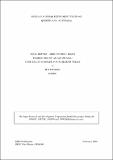| Author | Robotham, BG |
| Date Accessioned | 2012-11-13 |
| Date Available | 2012-11-13 |
| Issued | 2000 |
| Identifier | http://hdl.handle.net/11079/909 |
| Abstract | Sugarcane breeding and research programs currently rely on hand-cut sound whole-stalk samples for determination of commercial cane sugar (CCS) and other quality components. These samples of sugarcane are free from extraneous material and inferior quality cane and, hence, a biased sample of the material is harvested for milling from experimental plots (Skinner, 1976). The whole-stalk samples must be obtained while mechanised equipment operates in the plots. Research staff are exposed to the risk of injury from harvesters and cane haulout vehicles. The BSES annual Plant breeding program exceeds 250 individual trials along the Queensland coast. Billet samples are more compatible with current harvesting systems and this sampling method is more useful in predicting responses of commercial cane varieties to agronomic treatments. Collecting cane samples as billets is also more compatible with current harvesting systems. Dr T McRae initiated this need for an automated sugarcane billet sampler in 1994, and funding was obtained to determine design parameters for this machine. (McRae et al., 1998). An objective of this project was to build and field-test an automated sugarcane billet sampler. This project continues the work of BS118S, which quantified the need for a billet sampler in sugarcane research trials. |
| Language | en |
| Part of Series | BSES Internal Report; 2000 No 996 Report SD00001; SRDC BSS156 |
| Subject | Mechanisation Enhancements |
| Subject | Selection efficiency |
| Subject | Automated mechanical billet sampler |
| Subject | Cane samples |
| Subject | Design parameters |
| Subject | Varieties |
| Subject | Plant breeding |
| Title | Production of an automated cane billet sampler for research trials : SRDC final report BSS156 |

